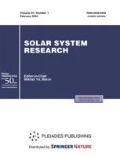Abstract
The peculiarities of the airborne LAZMA instrument applied for the measurement of the isotopic and elemental composition of Phobos’ regolith by the method of laser time-of-flight mass spectrometry are discussed. These measurements may confirm the assumptions that the material of Phobos is an initial substance with a composition close to carbonaceous chondrites, from which the Earth was formed. The results of the measurements may also confirm the original mechanism of the formation of the anomalous absorption of Phobos’ regolith suggested in this study. The obtained results regarding the elemental composition of the regolith may contain information about the conditions of the formation of Phobos, as well as provide information about it age. The scientific tasks of individual experiments and ways for their realization are considered in the paper. A detailed description of the airborne instrument and the principle of its operation is presented. The analytical and technical characteristics of the instrument and the peculiarities of constructive decisions are given. Data on the most important functional assemblies of the instrument, the development and transmission of scientific information to the Earth, are considered. The mass spectra presented in the paper were obtained by airborne instruments during the course of their laboratory test and the selection of the operating regime. It is demonstrated that the LAZMA instrument is the first version of the original next-generation airborne instrument constructed at the Space Research Institute and patented in Russia.
Similar content being viewed by others
References
Brinckerhoff, W.B., Managadze, G.G., McEntier, R.W., et al., Laser Time-of-Flight Mass Spectrometry for Space, Rev. Sci. Instr., 2000, vol. 71, pp. 536–545.
Cherepin, V.T., Ionnyi mikrozondovyi analiz (Ionic Microprobe Analysis), Kiev: Naukova dumka, 1992.
Managadze, G.G., Sagdeev, R.Z., and Shutyaev, I.Yu., USSR Inventor’s Certificate no. 1218852, Byull. Izobret., 1987, no. 17.
Managadze, G.G. and Sagdeev, R.Z., USSR Inventor’s Certificate no. 1190849, Byull. Izobret., 1987, no. 5.
Managadze, G.G. and Shutyaev, I.Yu., Exotic Instruments and Applications of Laser Ionization Mass Spectrometry in Space Research, Laser Ionization Mass Analysis, 1993, vol. 124,chap. 5, pp. 505–545.
Managadze, G.G., RF Patent 2096861, Byull. Izobret., 1997a, no. 32.
Managadze, G.G. and Managadze, N.G., Quantitative Reference-Free Analysis of Alloys by Means of Laser Time-of-Flight Mass Spectrometry, Preprint of. Space Research Institute of Russian Academy of Science, Moscow, no. Pr-1962, 1997b.
Managadze, G.G. and Managadze, N.G., Quantitative Reference-Free Analysis of Alloys by Means of Laser Time-of-Flight Mass Spectrometry, Zh. Teor. Fiz., 1999, vol. 69, no. 10, pp. 138–142.
Managadze, G.G., Chumikov, A.E., Managadze, N.G., et al., Mass Spectrometer Researches of Anomalously High Light Absorption by Phobos Surface from the Board of Space Station, Tezisy dokladov. Tretii s“ezd VMSO. II Vseros. konf. s mezhdunarodnym uchastiem “Mass-spektrometriya i ee prikladnye problemy” (Proc. 3rd All-Russian Mass-Spectrometer Society Meeting. II All-Russian Conf. with International Participation “Mass Spectrometry and Its Applied Problems”), Moscow, Sept. 3–7 2007.
Managadze, G.G., Plazma meteoritnogo udara i dobiologicheskaya evolyutsiya (Plasma of Meteoritic Impact and Prebiotic Evolution), Moscow: Fizmatizdat, 2009.
McKay, D.S., JSC-1: A New Lunar Soil Stimulant, Engineering, Construction, and Operations in Space IV, Amer. Soc. Civil Eng., 1994, pp. 857–866.
Rohner, U., Whitby, J., and Wurz, P., A Miniature Laser Ablation Time-of-Flight Mass Spectrometer for in situ Planetary Exploration, Meas. Sci. Tech., 2003, vol. 14, pp. 2159–2164.
Sagdeev, R.Z., Balebanov, V.M., and Zakharov, A.V., “Fobos” Project: Planetary Researches, in Trudy Mezhdunar. konf. po proekty FOBOS AN USSR (Proc. Int. Conf. on FOBOS Project. USSR Academy of Science), Moscow: IKI RAN, 1986, pp. 7–47.
Sagdeev, R.Z. and Zakharov, A.V., Brief History of the Phobos Mission, Nature, 1989, vol. 341, no. 6243, pp. 581–618.
Starukhina, L.V. and Shkuratov, Yu.G., On Phobos Surface Composition, Astron. Vestn., 1997, vol. 31, no. 5, pp. 427–433.
Author information
Authors and Affiliations
Additional information
Original Russian Text © G.G. Managadze, P. Wurz, R.Z. Sagdeev, A.E. Chumikov, M. Tuley, M. Yakovleva, N.G. Managadze, A.L. Bondarenko, 2010, published in Astronomicheskii Vestnik, 2010, Vol. 44, No. 5, pp. 405–413.
Rights and permissions
About this article
Cite this article
Managadze, G.G., Wurz, P., Sagdeev, R.Z. et al. Study of the main geochemical characteristics of Phobos’ regolith using laser time-of-flight mass spectrometry. Sol Syst Res 44, 376–384 (2010). https://doi.org/10.1134/S0038094610050047
Received:
Published:
Issue Date:
DOI: https://doi.org/10.1134/S0038094610050047




